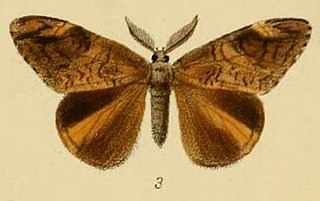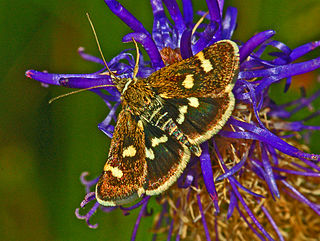
The Supreme Court of Illinois is the state supreme court, the highest court of the judiciary of Illinois. The court's authority is granted in Article VI of the current Illinois Constitution, which provides for seven justices elected from the five appellate judicial districts of the state: three justices from the First District and one from each of the other four districts. Absent mid-term vacancy, each justice is elected for a term of ten years, which may be renewed and the chief justice is elected by the court from its members for a three-year term.

Orgyia is a genus of tussock moths of the family Erebidae. The genus was described by Ochsenheimer in 1810. The species are cosmopolitan, except for the Neotropical realm.

Apantesis is a genus of tiger moths in the family Erebidae first described by Francis Walker in 1855. They are found in North and Central America.

Euchaetes is a genus of moths in the family Erebidae. It was described by Thaddeus William Harris in 1841.

Virbia is a genus of tiger moths in the family Erebidae. The genus was erected by Francis Walker in 1854.

Aroa is a genus of moths in the subfamily Lymantriinae first described by Francis Walker in 1855. Species are distributed in South Africa, China, throughout India, Sri Lanka, Myanmar, and Java.

Clostera is a genus of moths of the family Notodontidae. It consists of the following species:

Hexatoma is a genus of crane fly in the family Limoniidae.

Oligocentria semirufescens, the red-washed prominent moth or rusty prominent, is a moth of the family Notodontidae. The species was first described by Francis Walker in 1865. It is found in North America from Nova Scotia west to Vancouver Island, south to Florida, Colorado and central California.

Heterocampa is a genus of prominent moths in the family Notodontidae. There are about 18 described species in Heterocampa, found in North, Central, and South America.

Odontiinae is a subfamily of moths of the family Crambidae. The subfamily was described by Achille Guenée in 1854.
Oligocentria pinalensis, the Arizona prominent, is a moth of the family Notodontidae. It is only found within the Pinal Mountains of central Arizona. Due to its extremely limited known range, Oligocentria pinalensis is at a high risk of becoming extinct from isolated events, such as a forest fire. There is not enough current population data to make a full conclusion of its present status. Although it has been listed by the NatureServe conservation status as "GH" or possibly extinct, date of listing of status was 2002. The species was first described by F.H. Benjamin, a pan-pacific entomologist, in a publication from 1932.

Heterocampinae is a subfamily of prominent moths in the family Notodontidae. There are at least 60 described species of Heterocampinae in North America.
Oligocentria paradisus is a species of moth in the family Notodontidae. It was first described by Foster Hendrickson Benjamin in 1932 and it is found in North America.

Cecrita is a genus of prominent moths in the family Notodontidae. There are about eight described species in Cecrita, found in North, Central, and South America.













